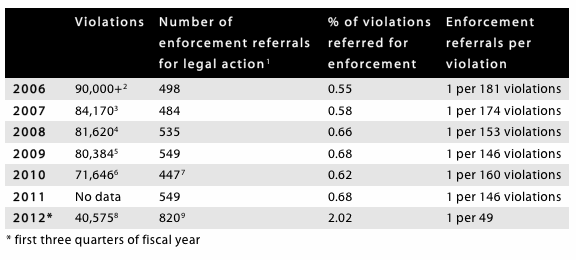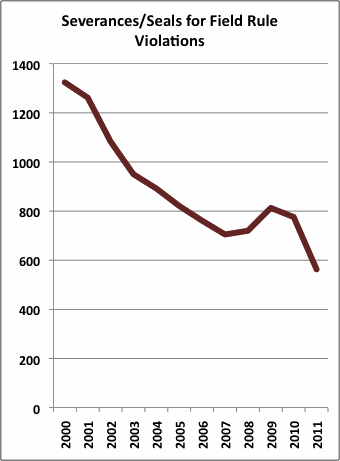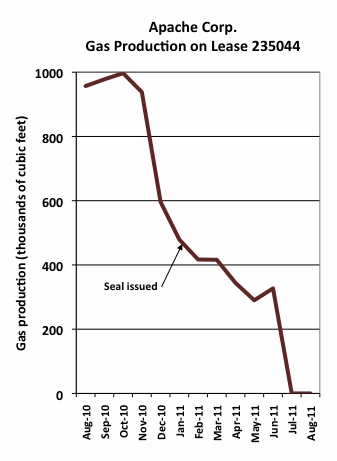Texas Oil & Gas Enforcement - Enforcement Actions
When inspectors find violations of oil and gas rules and statutes, the Railroad Commission may undertake an enforcement action and issue a monetary penalty against the operator -- but only after the operator charged with a violation has had the opportunity for a public hearing.[1] Operators may protest the enforcement action and go to a hearing, or choose to not protest the enforcement action and simply pay the penalty.
Prior to 2012, there was no simple way to find statistics related to oil and gas enforcement actions in Texas. As a result of Rider 17 of the 2012-2013 General Appropriations Act, the RRC now has to publish information about enforcement data on its web site, including enforcement activity, violations, the amount of final enforcement penalties assessed to the operator, and a quarterly report that includes a section on enforcement trends.[2]
Information on protested and unprotested enforcement actions can be found in RRC hearings and order files, but this system is extremely cumbersome to navigate. For example, it is not possible to search for protested enforcement actions by date. Meanwhile, unprotested actions are only categorized by hearing date in the Master Default Orders. So one must go through each individual file to find out operator names, which rules were violated, and penalties issued.
Actions not frequent enough to deter violators
Enforcement actions are not taken for every violation - far from it. According the Sunset Commission, the RRC relies on the discretion of each district office to determine which violations should be referred to the legal department for enforcement action, and very few enforcement referrals are made compared to the number of violations identified by RRC field staff.[3] The Sunset Commission found that in 2009 Texas oil and gas inspectors found more than 80,000 violations of state rules, yet field staff forwarded less than 4 percent of these violations to the agency’s central office for enforcement action. In contrast, says the Sunset Commission, the Texas Commission on Environmental Quality forwarded about 20 percent of its 11,000 violations for enforcement action.
Based on our research, it appears that the percentage of oil and gas violations forwarded for enforcement action was actually lower than 4% in 2009. The following table shows that between 2006 and 2010 less than one percent of all violations were referred to RRC enforcement staff. The first three quarters of 2012 showed an increase in enforcement referrals, but still, only slightly more than 2 percent of violations were referred for legal action. It's not clear why there has been a surge in enforcement actions in 2012, nor it is certain that RRC will continue to take actions at this higher rate.
RRC enforcement statistics (2006 - 2010)

Click chart for larger, footnoted version
Compared to some other states, Texas has a low enforcement rate. As seen in the table above, in 2010 RRC district offices made just one enforcement “referral” per 160 oil and gas violations. Meanwhile, that same year Pennsylvania took one enforcement action per 3.3 violations, and Ohio took one enforcement action per 48 violations.[4]
The primary consequence of taking few enforcement actions is that it sends a message to operators that they can break the rules and get away with it. Thus, there is no strong incentive to comply with RRC rules. In its 2011 review, the Sunset Commission found that “. . . the Commission takes relatively few enforcement actions, resulting in a lack of deterrence for future noncompliance. While there is no standard for how many violations should result in a monetary sanction, action should be frequent enough to deter future violations.”[5]
One enforcement action per 160 violations is highly unlikely to motivate oil and gas companies to comply with the Texas oil and gas rules. Perhaps the recent increase in enforcement actions will provide an increased incentive to operators - but this remains to be seen.
Severances and Seals - could be used more effectively
The RRC has an alternative to a full-blown enforcement action. In December 2010, RRC Commissioner Michael Williams told the Sunset Advisory Commission that ". . .lease severance is a valuable tool to enforce our rules, deter future violations and bring operators into quick compliance, without the delay and expense of an enforcement hearing."[6]
The Texas Administrative Code states that, the Commission “may shut in and seal any well if it appears that the operator of a well has violated or is violating any statutes, rules, permits, or orders of the Commission. Prior to shutting in or sealing a well operators are sent a letter by the Commission that instructs them to correct the violation, and provides a date by which compliance must be achieved. If compliance does not occur, the Commission may then seal the well.”
A severance or seal is intended to prevent an operator from producing oil and gas and from transporting oil or gas from a well with a lease. When the violation(s) are corrected, the operator typically pays a $300 fee to obtain a Certificate of Compliance, which must be reissued before the severance or seal can be lifted. In 2008, 1,915 operators paid this reissuance fee, generating close to $1.5 million in revenue for the RRC.[7]
What types of wells get severed or sealed?

Click chart for larger version
A 2012 investigation by EnergyWire found that the RRC is more likely to sever or seal wells for production violations, e.g., a late or erroneous production report or ‘overproduction’, than for health, environmental or safety violations. RRC told Energywire that the reason more wells are shut down for production than safety problems is that production severances are computer-generated and the agency can look at every well monthly. RRC data obtained by EnergyWire showed that less than 10 percent of the total number of severed or sealed leases were shut down for "field rule violations" –problems found during inspections– in 2010.
As seen in the chart, Earthworks’ analysis of RRC data shows that in 2011 the number of severances and seals applied for field rule violations hit an 11-year low. It’s not clear why there has been such a sharp decline in the use of severances and seals for field rule violations, but the data demonstrate that it is a tool that has been more widely utilized for field rule violations in the past.[8]
How effective are severances/seals?
In the past five years, the RRC issued between 6,000 and 8,500 severances/seals per year.[8]

Click chart for larger version
The power of the severance or seal is that it is supposed to stop production of oil or gas at a well or lease, and consequently operators lose revenue until they can bring the wells back into compliance. The potential loss of revenue should be a motivation to quickly resolve compliance problems. But as seen in the chart, the percentage of resolved severances on oil leases and seals on gas leases has been dropping.[9]
Between 2000 and 2005, between 80 and 84% of severances and seals were resolved (the violations had been corrected and the severance removed). In 2011 there were 8,485 leases that had a severance/seal for a particular violation, and as of April 2012 only 51% of those severances/seals had been resolved.
The drop in resolved severances and seals suggests that operators are becoming less conscientious about coming into compliance once actual production has been cut off. It also suggests a need for follow-up inspections to ensure that the violations that lead to severances/seals are corrected within a certain time-frame. If they are not corrected, the cases should be referred to RRC enforcement for further legal action.
Not all severed/sealed wells stop producing oil or gas

Click chart for larger version
For example, on Oct. 5, 2010 Apache Corporation was sent a certified letter informing the company of a field rule violation. On Jan. 4, 2011 a seal was issued, so production should have stopped. As seen in Chart 26, however, production on Apache’s lease did not stop until July 2011.[FN]
Similarly, in 2003 Aminex USA, Inc. was ordered to pay a $1,000 fine for producing oil from numerous wells on a lease from June 1, 2002 through May 31, 2003, despite the fact that the lease had been severed on May 29, 2002.[FN]
The violations were corrected, but the company failed to obtain a certificate of compliance as required by law, and so production should not have resumed.[FN]
The ability to stop production at wells that are in violation of rules is a powerful enforcement tool that should be more widely applied to encourage compliance with field rule violations. The addition of more enforcement staff to ensure that wells are physically sealed to stop production could increase the effectiveness of severances and seals in Texas.
There are a couple of reasons that production does not necessarily stop following the issuance of a severance or seal. First, these actions do not always involve an inspector going to the site and physically sealing the well to prevent production. In speaking with RRC compliance and field operations staff, we were told that because the agency is understaffed it could be a month or more before inspectors physically get to wells that have been severed—if they make it there at all. RRC was not able to provide a statistic on how many wells are physically sealed.
Second, even when wells are physically sealed, operators sometimes break the seals and continue producing oil or gas or injecting oilfield wastes.
- On November 14, 2003, the main power supply box at an injection well on the Winters Lease was sealed with Commission seal #16970 and tagged for easy viewing. An inspection conducted on January 6, 2004 indicated that the operator “had caused or allowed the Commission seal to be broken at the power supply box.”[FN]
- On March 5 and April 2, 2009, the Posey No. 1A well was found to be open and oil was flowing oil into a tank, in clear violation of a 2007 severance order. On April 7, 2009, an inspector shut in the Posey No. 1A and sealed it with Commission seal # 241006. On July 14, 2009, an inspection revealed that the Commission seal had been removed. A second seal was installed on the well, and an additional seal was installed on top of the oil storage tank. On July 29, 2009, an inspector found that the seal on the oil storage tank had been cut and removed.[FN}
Penalties - too few, and too modest to change behavior?
Prior to 2012, the RRC did not publish easily accessible statistics on penalties assessed for oil and gas violations. However, some information on oil and gas penatlies were found from other sources. For example, the Texas State Auditor reported that, “in fiscal year 2006, the Commission assessed $1.4 million in penalties,” while the Sunset Commission reported that the RRC collected more than $2 million in penalties in 2009.[10]
The RRC is now required by Rider 17 of the 2012-2013 General Appropriations Act to publish “the amount of final enforcement penalties assessed to the operator” on its web site. During the first three quarters of fiscal year 2012, RRC assessed $856,868 in penalties. Over that period 802 violations were referred for enforcement action, which means the average penalty per enforcement referral was $1,070. This is down from 2009 and 2006, when RRC collected an average of $3,600 and $2,800 per enforcement referral, respectively.[10]
According to the Sunset Commission, “the efficient and fair use of penalties plays a key role in deterring and punishing violators, and thus increases compliance.”[11]
The Texas Oil and Gas Association (TXOGA), on the other hand, has argued that penalties won’t necessarily deter future violations because “violations are more likely to result from lack of knowledge of regulations.”[12]
If penalties were used more frequently and effectively, operators would soon learn that it is not acceptable to be ignorant of the rules. This is the argument put forth by the Sunset Commission, which found that “even modest fines for less serious, but frequent violations can substantially affect compliance, especially once word spreads that coming into compliance will no longer suffice to avoid a penalty.”[11]
TXOGA has argued that small fines are not worth the trouble:
--Texas Oil and Gas Association
The Texas Oil and Gas Association may have a point. The maximum penalties for some rule violations are so low that it may not make financial sense for the RRC to pursue enforcement actions against violators.
The RRC has taken a partial step toward increasing the penalties levied against oil and gas operators. In February 2012 the RRC proposed a rule (3.107) to increase the suggested minimum penalty for most rule violations.[13] For example, under the proposed new rule the suggested minimum penalty for missing or insufficient wells signs would increase from $250 to $500 (for wells) and $1,000 (for entrance signs and tank battery signs) per day. Even if the rule passes, however, the new penalty amounts in the rule would act only as a guideline for enforcement staff. The ultimate penalty suggested by RRC enforcement staff would still be ”any amount up to the statutory maximum when warranted by the facts in any case.”
In 1983, the maximum civil penalty for violating an oil and gas environmental or safety rule was set at $10,000 per day, and it has not changed since that year.
If merely adjusted for inflation, the maximum penalty of $10,000 per day in 1983 dollars would amount to approximately $23,000 per day in 2012 dollars. In 2011, Texas Senate Bill 1293 proposed to increase the maximum penalty to $25,000 for each day of continuing violation. This bill did not pass.
Other states have recognized and acted on the need to increase administrative penalties for oil and gas violations. In 2012, Pennsylvania passed a bill that increased the maximum civil penalty for unconventional oil and gas well violations to $75,000 plus $5,000 per day. Conventional wells can be penalized $25,000 plus $1,000 per day of continuing violation. The Pennsylvania House Republican Caucus said the new penalty provision “holds drillers accountable” for their actions.
Penalties can be an effective deterrent for those who violate oil and gas rules. But in order to have a deterrent effect, penalties must be applied frequently enough to send a message that non-compliance comes with a cost. A penalty of a few thousand dollars, however, is unlikely to have a dramatic effect on the behavior of some oil and gas operators. To show that it is serious about oil and gas enforcement, RRC should assess higher minimum penalties for violations and increase the maximum amount that operators can be penalized for breaking rules designed to protect public health, safety and the environment.
For more information:
- Earthworks: Enforcement Report - RRC: Public should not have confidence that oil and gas development is occurring responsibly in Texas. Report
- Earthworks: Texas Oil & Gas Enforcement. Web page
- Earthworks: Texas Oil & Gas Enforcement - Inspections. Web page
- Earthworks: Texas Oil & Gas Enforcement - Violations. Web page
- Earthworks: Texas Oil & Gas Enforcement - Enforcement Actions. Web page
- Earthworks: Texas Oil & Gas Enforcement - Public Participation. Web page
Endnotes
1 Section 81.0532, Texas Natural Resources Code
2 General Appropriations Act for the 2012-13 Biennium. 82nd Texas Legislature Regular Session, 2011. Sept. 12, 2011.p. V-60.
3 Sunset Advisory Commission. July 2011. Final Report - Railroad Commission of Texas. p. 33.
4 Comparison of enforcement actions in Texas, Pennsylvania and Ohio.

Click chart for larger, footnoted version
5 Sunset Advisory Commission. July 2011. Final Report - Railroad Commission of Texas. p. 33.
6 Williams, Michael. Dec. 21, 2010. Testimony before the Texas Sunset Advisory Commission.
7 Railroad Commission of Texas. Sept. 2009. Self-Evaluation Report. Submitted to Texas Sunset Advisory Commission. p. 101.
8 Severances and seals for field rule violations.

Click chart for larger, footnoted version
9 Outstanding and resolved severances and seals.

Click chart for larger, footnoted version
10 Average penalty per enforcement action

Click chart for larger, footnoted version
11 Sunset Advisory Commission. July 2011. Final Report - Railroad Commission of Texas. p. 33.
12 Sunset Commission Meeting and Public Testimony re: Railroad Commission. December 15 and 16, 2010. Testimony of the Texas Oil and Gas Association. p. 7.
13 Figure 16 of the proposed rule 3.107 outlines the proposed new minimum penalties. Most of the penalties have increased as a result of the proposed rule. Some, such as the penalty for violation of rule 13(b)(1)(b) “open casing/tubing” actually decreased from $1,000 - $10,000 in the old guidance to $1,000 - $5,000 in the new. Previously, recommended minimum penalties were outlined in an RRC guidance document “Recommended Standard Penalty Schedule for Enforcement Cases.” A copy of this document was obtained by Susan Law, Earthworks, from Richard Atkins, RRC Hearings Examiner. Sept. 23, 2011. Click here to view the old penalty schedule.
Tagged with: texas railroad commission, texas, sanctions, regulations, penalties, fracking, fines, enforcement, drilling
Follow Earthworks